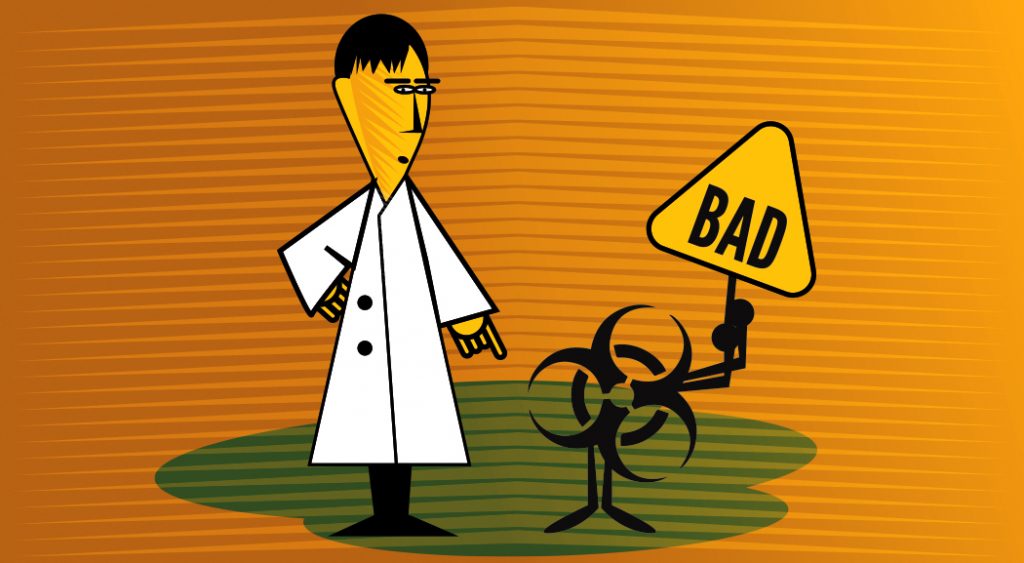When safety in the lab depends on instructions, thoughtful (and colorful) signage makes a huge difference in creating standard, impactful communication.
I recruited David Brammer, executive director of Animal Care Operations and Chief Veterinarian at UH, to help me better understand the components of effective science lab signage and communication.
Not only is Dr. Brammer a great scientist, but he’s green belt lean six sigma certified, which is a great knowledge base when it comes to lab communication and organization. To create effective signage and labeling, he says, you have to reduce the visual clutter.
“Before you get into organizing your lab, you must get rid of old stuff,” says Dr. Brammer. “There are resources and tools out there to help facilitate lab organization and I use the 5S Model.”
Step it Up with the 5S Model
The 5S Model represents words that describe the steps of a workplace organization process. This method is part of lean six sigma training and teachings.
According to Dr. Brammer, this model is useful in lab operations because it keeps everything orderly at all times and saves money (because supplies and equipment aren’t overly purchased).
Here are the five elements of the 5S Model and what you can do to improve your lab organization:
1. Sort
Determine your current lab inventory and eliminate unused items and/or repair usable item.
2. Straighten
Place tools and equipment in places that are appropriate and make sense to everyone. Basically, like our mothers and fathers use to tell us, everything has a home.
3. Standardize
Keep messages and colors consistent in all areas of the lab.
4. Shine
All equipment and tools must work and be labeled with their home location.
5. Sustain
Periodically review your work space and eliminate unused items and/or repair usable items.
As you can see, the entire 5S Model is structured to be a continuous cycle of organization.
“Actually, in my labs, we don’t keep a lot of signs around,” says Dr. Brammer. “We keep the labs devoid of signs except the main, important ones that address messages associated with the 5S Model.”
While interviewing Dr. Brammer, I was able to observe his labs and I saw signage taped to working spaces and on countertops. “We do this because it allows us to put the material back in place even with multiple people using the item,” says Brammer.
I was very impressed with our Animal Care Operations labs. Every piece of equipment and tool (even the soap) has a home – and is labeled. And I must say, Dr. Brammer definitely appreciates the artistic side of lab communication and signage. The color scheme consisted of UH colors with a lovely mauve accent to make things interesting to look at.
“Our first signs were very basic (not very pretty), black and white,” says Dr. Brammer. “But after studying different visual workplace methods, we incorporated color patterns to differentiate between bio hazardous and non-bio hazardous areas and to make things visually digestible and appealing.”
It is quite clear, the UH Animal Care labs are in tip top shape and the 5S Model is definitely a fantastic method to incorporate into a science lab.
Tips for Baseline Hazard Communication
In addition to the insightful information provided by Dr. Brammer, I ran across other useful tips for creating effective lab communication and signage. These nuggets of information help protect you, students, lab managers and science experiments. Who would’ve thought a well-planned and thought-out color scheme could save us all.
Material Safety Data Sheets: Embrace them…they are your friend
If a critical moment occurs, lab managers will know the chemical or equipment involved and be able to quickly address the incident and secure the safety of lab workers and experiments.
Use color consistently
Determine your color scheme and standardize it. Always make sure lab safety messages are connected to the same color every time it’s communicated.
Draft a safety communications plan
Nothing is more devastating than knowing a tragedy could have been prevented through a plan. Lab managers…write a comprehensive communications safety plan, share it with your staff and periodically review the plan to ensure everyone is familiar with how to proceed if an emergency situation develops.
Of course face-to-face communication is key to positive experiences in a science lab, but other forms of communication are just as important.
Proper usage of color, graphics and sign placement allow scientists to make better safety choices, which may result in better experiment outcomes and team moral (maybe because nobody developed some strange rash due to importer labeling of a chemical).
Overall, organizing your lab, developing standard, appealing signage and creating a sound hazard communications plan are super-duper important.
Be well and stay safe!



